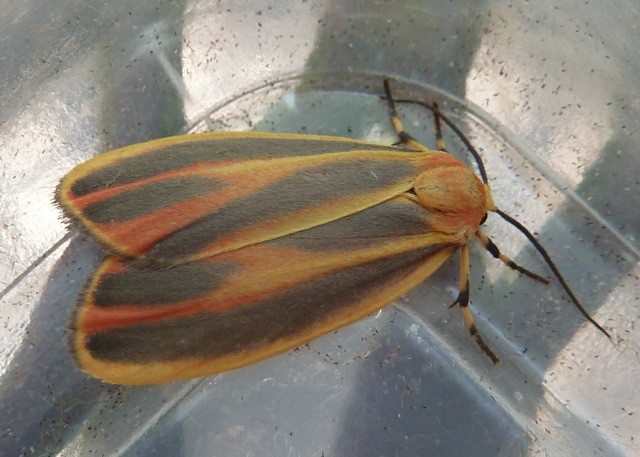Elbee Bailey was visited by this colorful moth and sent us this photograph on the right for identification. Frequently we find something and have no way to get a "decent" picture. I would encourage you to try anyway. This insect has a distinctive appearance that can be identified as a painted lichen moth, Hypoprepia fucosa. I cropped her photo and sent it to INaturalist which ID'd it as its first choice. This site is far more forgiving than Bugguide although it is less authoratative. This is a common moth which also helps but common is always a good place to start thinking about an identification.
Another trick I find helpful is to Google a species name followed by "MDC." The Discover Nature Field Guide has an amazing number of species common to Missouri. Nothing in the first pages of Googling brought up any information on anything except photographs for ID. In this case, "painted lichen moth MDC" brings up this site. Here is a sample of the content.
"Larvae feed on lichens, the often crusty-looking plantlike growths that develop on trees and rocks. Lichens are made of a fungus and a symbiotic partner organism that has the ability to conduct photosynthesis (usually, this partner is an alga). The larvae also feed on mosses and algae that can grow on trees."
 |
| H. fucosa - Tom Murray |
=====
Some of my favorite go to resources.
Plants
Illinoiswildflowers is a dynamite resource. For a quick search, google "plant name Illinois" and it will usually come up as the first choice. The name is deceptive as they cover everything from trees to moss. They also have databases on insect and mammal connections with plants including faunal associations.
Insects
The Entomology Department at University of Florida as a Creatures site with amazing details on most species. Again Googling a "species name Florida" will usually locate it as one of the top choices. Look for "entnemdept.ufl.edu"
For fun facts on selected species I hope to find something from my favorite Buglady at the University of Wisconsin Milwaukee Field Station. Try Googling "click beetle
Buglady" or just click on this link for a sample.
Buglady" or just click on this link for a sample.
Bugguide.net- Free to join and photos are reviewed by experts.
INaturalist.com of course.
Seek phone app is a new favorite, like INaturalist but you just point your camera and it responds.

